When people think of Africans in Indian history, Malik Ambar tends
to be the first name to come to mind. Brought to Ahmadnagar as a
warrior-slave in the 16th century, he rose to be the general of
the Deccan sultanate’s army—and eventually its regent.
Yet, Ambar was only the most successful of thousands of Africans
brought to India by Arab and Portuguese slavers across the Arabian
Sea. Thousands of others came as mercenaries and merchants. Today,
the Sidis—as people of African origin living in India for
centuries call themselves—are a fast disappearing community.
Separated by appearance, if not by culture, they are largely
misunderstood.
British photographer Luke Duggleby is attempting to change that.
In the ambitious Sidi Project, Duggleby documents the lives of the
community—not just in India but also in Pakistan.
Duggleby has been travelling to India for 18 years, but he learnt
of the Sidis in India only a few years ago while working on a
documentary on the Little Rann of Kutch. His translator and guide,
while describing the communities of Gujarat, mentioned the Sidis.
Duggleby was hooked.
Around 20 years ago, at the start of his career, Duggleby had
spent six months in Tanzania. “Many of my first experiences of
travel and photography were in various parts of Africa,” he says.
“My life then took a turn east and I ended up in Asia where I have
been based ever since. I have always had a deep fascination for
both continents so when I heard about the Sidi I became slightly
obsessed and began researching more and more about the topic.”
This eventually led to his self-funded travels to India and
Pakistan over three years. In January 2013 and 2015, he visited
Gujarat, Karnataka and Mumbai. In early 2014, he went to Hyderabad
and Bedin in Sindh, Pakistan.
Community activism
The origins of the Sidis have been lost over time, and because of
cultural assimilation. Nobody knows exactly which part of Africa
they might have come from.
“We don’t even have our own language,” says Mohan Siddi, a
community leader from Karnataka who worked closely with Duggleby
on parts of his project in January. “We speak Konkani in Karwar,
close to Dharwar, where people speak Marathi. Muslim Sidis speak
Urdu and Gujarati. But we still have our music.”
In Gujarat and Karnataka, where most Sidis live, music remains the
enduring link to Africa. But even this link is fading in places
such as Hyderabad, where Siddi says the small community is
reluctant to display its African identity.
In 2003, Karnataka included Sidis on the list of Scheduled Tribes,
helping them cement their identity in that state. But there is
still much left to do. Siddi says he has plans to unite Africans
across India. Last month, he registered an organisation in Mumbai
as a platform to contact other Sidis in Sri Lanka and Pakistan.
The group, he says, will work for the community’s upliftment.
Siddi is also critical of the scores of photographers and scholars
who have come to study Sidis, taken what they needed and left. “It
is as if we are animals in a zoo,” he says. “That is why I now
insist that anyone who wants to approach us should work for the
upliftment of the community.”
For Duggleby, however, this is a continuing project.
“The ultimate aim of this project is to document the many other
communities that form part of this Indian Ocean Africa diaspora in
other countries, not just India,” he says. “By doing this I hope
to tell people about this horrific part of history through the
people that are a result of it today and at the same time give the
Sidi communities a platform to be seen and learnt about, which
they so much crave.”
Moving ahead
Sidis in India today have to deal with fragmentation within their
community and discrimination from without.
Despite being Indian for centuries, Sidis constantly face racial
discrimination in India, where their identities or origins are not
fully understood. In Pakistan—where they are also known as
Sheedis—the community has suffered similar prejudice because of
their physical features.
One image stands out for Duggleby, he says. It was shot in Karachi
and shows two young girls studying after school. Both are Sidis,
but look very different from each other.
“To me, it shows the fragility of the Sidi community,” he says.
“Because of discrimination, many look to marry outside the Sidi
community and dilute their African appearance. For some that is
how they can avoid this discrimination, but for many this is seen
as the very disappearance of the Sidi people themselves.” #KhabarLive






